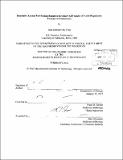| dc.contributor.advisor | Frank B. Gertler. | en_US |
| dc.contributor.author | Van Veen, John Edward | en_US |
| dc.contributor.other | Massachusetts Institute of Technology. Dept. of Biology. | en_US |
| dc.date.accessioned | 2012-10-10T15:44:22Z | |
| dc.date.available | 2012-10-10T15:44:22Z | |
| dc.date.copyright | 2012 | en_US |
| dc.date.issued | 2012 | en_US |
| dc.identifier.uri | http://hdl.handle.net/1721.1/73777 | |
| dc.description | Thesis (Ph. D.)--Massachusetts Institute of Technology, Dept. of Biology, 2012. | en_US |
| dc.description | Cataloged from PDF version of thesis. | en_US |
| dc.description | Includes bibliographical references. | en_US |
| dc.description.abstract | Vertebrate nervous system development requires the careful interpretation of many attractive and repulsive guidance molecules. For the incredibly complicated wiring diagram comprising the vertebrate nervous system to elaborate properly, the highly motile "growth cone" at the tip of an axon must sense extracellular embryonic cues and respond through a number of intracellular interactions leading ultimately to coordinated changes in cytoskeletal morphology and modulation of the axonal path. Here I describe axon pathfinding defects displayed by mice genetically deficient for all three vertebrate Ena/VASP homologues: Mena, VASP, and EVL. As has been reported previously in invertebrates, these defects share phenotypic overlap with those seen in mice genetically deficient for the repulsive guidance molecules Slit and Robo. I find that the pathfinding errors observed in Ena/VASP deficient mice are likely a result of failure to respond to Slit/Robo. Furthermore, based on my findings, I propose a "four-step" model of growth cone responses to repulsive cues. Finally I find that the direct binding of Ena/VASP proteins to Robo seen in invertebrates is conserved and expanded in vertebrates. These interactions appear to be tunable by phosphorylation, suggesting a model by which context dictates the Ena/VASP:Robo interaction, potentially leading to changes in growth cone responsiveness to guidance cues. | en_US |
| dc.description.statementofresponsibility | by John Edward van Veen. | en_US |
| dc.format.extent | 148 p. | en_US |
| dc.language.iso | eng | en_US |
| dc.publisher | Massachusetts Institute of Technology | en_US |
| dc.rights | M.I.T. theses are protected by
copyright. They may be viewed from this source for any purpose, but
reproduction or distribution in any format is prohibited without written
permission. See provided URL for inquiries about permission. | en_US |
| dc.rights.uri | http://dspace.mit.edu/handle/1721.1/7582 | en_US |
| dc.subject | Biology. | en_US |
| dc.title | Repulsive axonal pathfinding requires the Ena/VASP family of actin regulatory proteins in vertebrates | en_US |
| dc.type | Thesis | en_US |
| dc.description.degree | Ph.D. | en_US |
| dc.contributor.department | Massachusetts Institute of Technology. Department of Biology | |
| dc.identifier.oclc | 810144504 | en_US |
